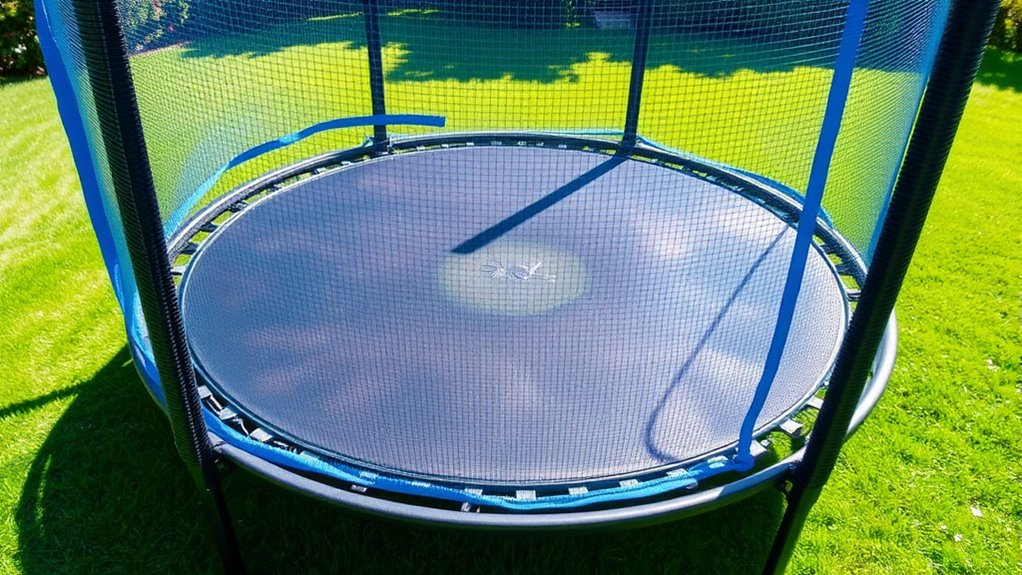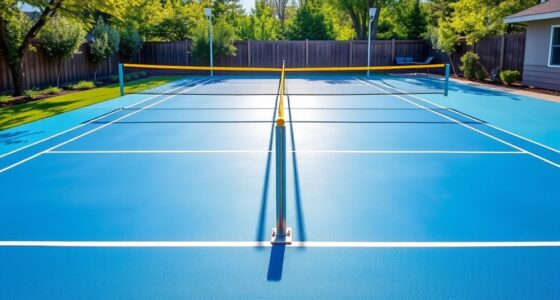Trampoline safety nets are essential because they act as a barrier to prevent falls and reduce injury risks during use. They surround the jumping area with durable mesh that helps keep jumpers safely within the trampoline. Proper installation and maintenance are vital for effectiveness. While they don’t stop all injuries, safety nets markedly lower the chance of serious falls. To learn more about how safety measures can protect you and your family, keep exploring the details.
Key Takeaways
- Safety nets act as barriers to prevent falls and reduce injury risks during trampoline use.
- Properly installed and maintained safety nets significantly enhance trampoline safety.
- Safety nets are most effective when combined with padding, supervision, and safe jumping practices.
- Injury data shows safety features, including nets, help lower fall-related injuries but don’t eliminate all risks.
- Regulations recommend enclosures as a key safety feature, indicating their necessity for safe trampoline use.

Trampoline safety nets are an essential safety feature designed to reduce the risk of falls and injuries while jumping. If you’re considering installing one, it’s because you understand that falls are a common cause of trampoline injuries. These nets act as a barrier, preventing jumpers from accidentally falling off the trampoline’s edge. They are typically made of durable mesh material that surrounds the jumping area, giving you peace of mind that your children or family members are less likely to take a tumble onto hard ground. Alongside safety nets, padding covers the frame and springs, further reducing injury risks from impact. This padding cushions any contact with the frame or springs, which are often responsible for cuts, bruises, or more serious injuries during rough landings or collisions. [Despite their widespread use and proven benefits, studies from 2002 to 2007 show that injury rates haven’t markedly decreased, even with safety nets and padding in place.] This might seem discouraging at first, but it underscores the importance of regular maintenance and proper installation. Safety equipment can only be effective if it remains in good condition and is used correctly. For example, torn or loose nets won’t provide reliable protection, and worn padding may fail to cushion impacts effectively. You should inspect your safety features frequently, especially after heavy use or adverse weather. Also, remember that safety nets mainly prevent falls off the trampoline; they don’t eliminate all injuries. Many accidents still happen when multiple jumpers are on the trampoline simultaneously or when jumpers collide mid-air. In fact, over 75% of injuries occur during such multi-user activities, highlighting the need for supervision and safe jumping practices.
Switching to a trampoline with safety enhancements, like soft-edged designs and enclosures, has shown to lower injury rates related to falls and equipment contact. Data from countries like Australia and the US indicate that these safety features improve overall outcomes, reducing injuries caused by falling off or hitting the frame. Still, injuries are not eliminated entirely, and some severity remains, especially among young children aged 1 to 9. In Alberta alone, over 1,600 emergency visits were recorded in a single year due to trampoline injuries, with fewer than 30% linked to falls. Most injuries come from impacts with the trampoline surface or collisions with other jumpers, not falls off the edge. The effectiveness of safety nets depends heavily on correct installation and consistent use, as improper setup can diminish their protective benefits. While safety nets do a good job of reducing certain injuries, they can’t prevent all accidents. Proper supervision, safe jumping techniques, and regular equipment maintenance are critical complements to safety enclosures. Regulations like those from ASTM recommend using net enclosures and padding, emphasizing correct installation and ongoing inspection. Ultimately, safety nets are necessary, but they’re just one part of a thorough approach to trampoline safety. Combining them with responsible use and maintenance helps ensure everyone can enjoy jumping with less risk of injury.
Frequently Asked Questions
How Do Safety Nets Affect Trampoline Bounce Quality?
You might wonder how safety nets impact your trampoline bounce quality. Typically, they don’t substantially affect your bounce because they’re designed to be lightweight and flexible. While some airflow restrictions could occur, especially with vented designs, most modern safety nets are engineered to minimize this issue. Your trampoline’s overall bounce depends more on the mat and springs, so adding a net mainly enhances safety without compromising your jumping experience.
Are There Any Health Risks Associated With Trampoline Safety Nets?
You might wonder if safety nets pose health risks. They can cause minor injuries like cuts or abrasions if torn or damaged. Nets may also trap debris or insects, leading to skin irritation or infections. Overconfidence from feeling protected might encourage riskier jumping, increasing injury chances. Additionally, poor maintenance or improper installation can weaken the net’s safety, putting you at greater risk of harm during use.
Can Safety Nets Be Installed on All Trampoline Models?
Back in the day, safety was often an afterthought, but now, you realize that not all trampoline models can accommodate safety nets. You need to check compatibility because nets are designed for specific sizes, pole configurations, and frame types. Without matching your trampoline’s model and structure, installing a safety net isn’t just difficult—it could be unsafe. Always verify manufacturer guidelines to guarantee proper fit and safety.
What Maintenance Is Required to Keep Safety Nets Effective?
To keep safety nets effective, you need to inspect them regularly for tears, holes, or fraying, and guarantee all attachment points are secure. Clean the nets with mild soap to prevent dirt buildup, and store or cover the trampoline during off-seasons. Follow manufacturer guidelines for replacement, usually every 2-5 years, and tighten hardware frequently. Regularly check frame and support structures for damage to maintain overall safety.
Do Safety Nets Increase or Decrease Overall Trampoline Accident Rates?
You might think safety nets are a silver bullet, but they don’t substantially cut overall injury rates. While they help prevent falls, many injuries happen from collisions or risky moves that nets can’t stop. Using nets together with padding, supervision, and safe jumping habits makes a real difference. So, they’re helpful but not the whole story—think of them as part of a bigger safety puzzle.
Conclusion
So, do you really want to take the risk of a serious fall? Installing a trampoline safety net might seem like an extra step, but it’s a simple way to keep everyone safe and prevent accidents. Think about the peace of mind it offers while your kids jump and play. Isn’t safety worth a little extra effort? In the end, a safety net isn’t just an accessory—it’s a essential safeguard for fun-filled, worry-free trampoline sessions.









